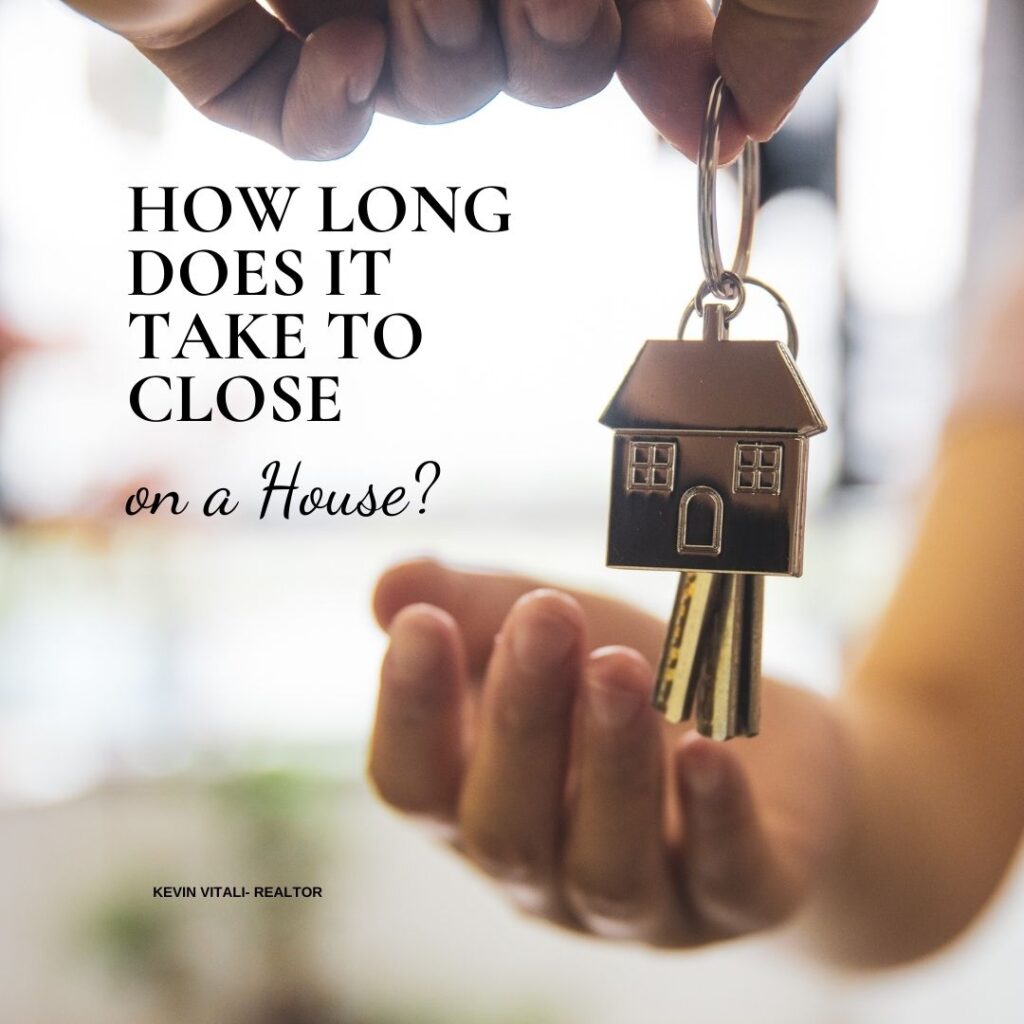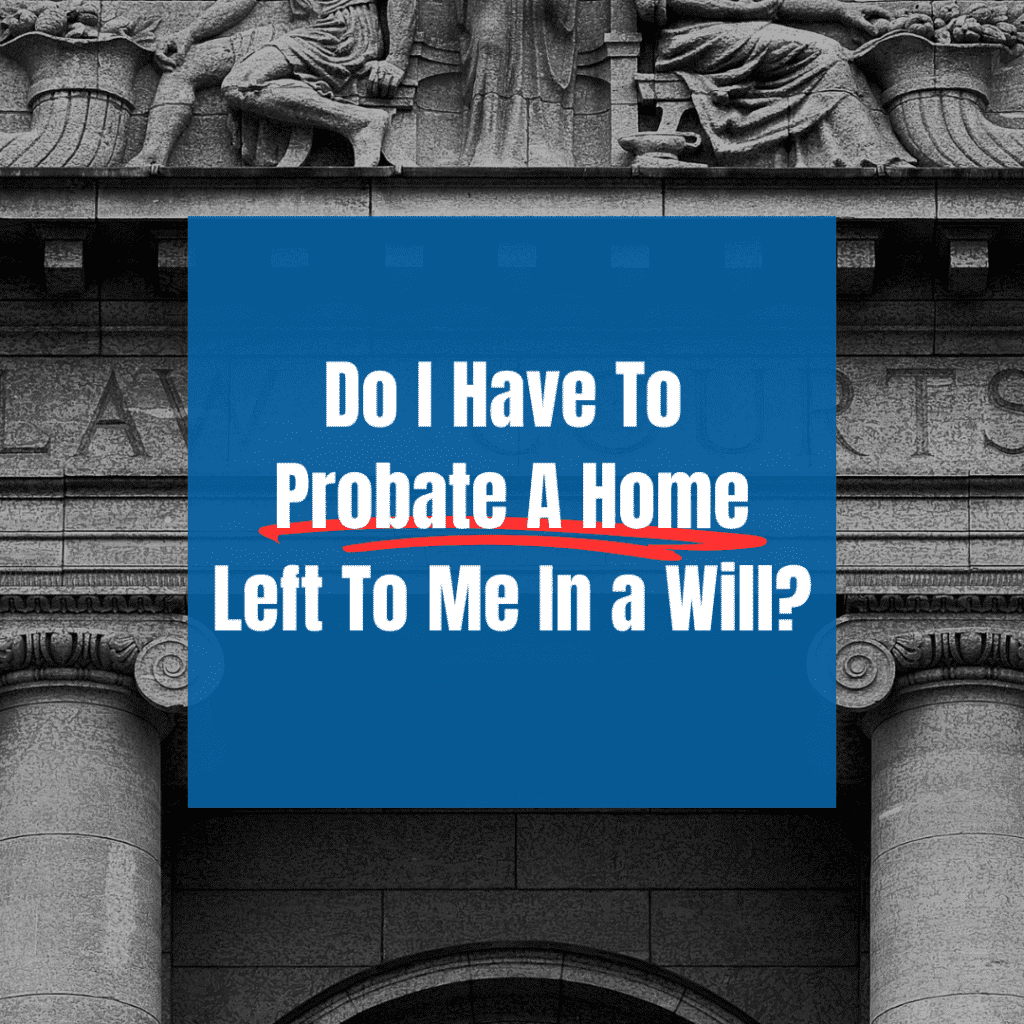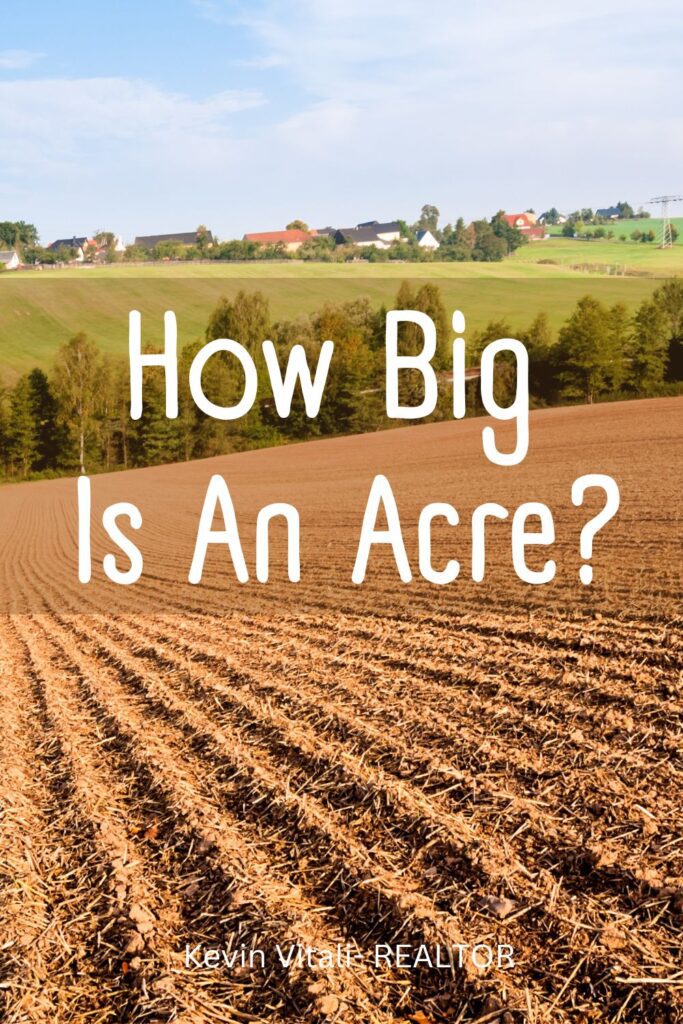
Regarding land, there are many different sizes and variations of acreage. But what exactly is and how big is an acre of land?
While there are many different meanings of the word “acre” depending on the context, most people use the word when talking about a measurement of land. An acre is a unit of measurement that dates back to Anglo-Saxon England in the 7th century.
These units were often used when taxing landowners based on how much land they owned or how much land a tenant worked.
Acres are still used to measure land for farming, property value, and other real estate transactions. It is also commonly used when discussing or reporting on property or agricultural land uses. This blog post will explore the history and how big an acre is as we know it today.
Jump To A Section....
Measurement Of Land
Commonly in the US as well as many other countries an acre is used as a standard land measurement. Other countries may use a hectare.
The hectare is the legal land measurement of the European Union. A hectare is 10,000 square yards which equal 2.471 acres or 40% of a hectare.
What Is An Acre?
As pointed out above, an acre is the common land measurement used in the United States. An acre is measured by square feet.
How Many Square Feet In An Acre of Land?
An acre of land consists of 43,560 square feet, a standard measurement often used in real estate and agriculture. Whether the land is shaped as a rectangle, circle, or any other form, the total area must always equal this number of square feet.
This size originates from historical definitions tied to farming and the British imperial system. Today, it serves as a universal measurement in countries like the United States and the UK.
-
- 4840 square yards
-
- 4,046.86 square meters
-
- 0.0015625 square miles or 1/640th
-
- 0.405 square hectares
Builder’s Acre
A “builder’s acre” is a term commonly used in real estate and land development to refer to a parcel of land that is roughly 40,000 square feet, which is smaller than a standard acre of 43,560 square feet.
The term is often used informally by developers to simplify lot sizes in residential construction. However, it is important to note that the builder’s acre is not an official measurement and may vary slightly by region or context.
The builder’s acre is typically used for marketing purposes, especially when subdividing large plots of land into residential lots. It helps developers round off numbers to make properties sound more appealing, even though the actual size is slightly smaller than a true acre.
Commercial Acre
A “commercial acre” is a term used in real estate to describe a parcel of land that is typically smaller than a standard acre, which is 43,560 square feet. The commercial acre is generally used to account for the space taken up by streets, sidewalks, and other public infrastructure, and is often defined as 36,000 square feet. This makes it approximately 83% of a standard acre.
The term is most commonly used in urban or commercial developments where public amenities reduce the usable land for building or commercial use. The concept of a commercial acre helps developers and planners calculate how much land is actually available for construction or use in a commercial project.
If you’re purchasing land, always check the exact size in square feet to avoid confusion.
What Shape Is an Acre?
An acre can come in any shape as long as it is 43,560 square feet. It can be porkchop-shaped, wedge-shaped it could, square, curved or even star-shaped.
The shape of an acre is not important it is the area of land that makes up the shape that is.
History of an Acre
Whenever you are dealing with real property there will always be a measurement assigned to the acreage the property sits on, either in square feet or fractions of an acre. And for most people, you just accept the term acre.
Acre comes from the Old English word aecer meaning an open field which came from the Latin word ager meaning field. Originally, the meaning came from what one man and a yoke of oxen could plow in one 12-hour day.
Does the meaning seem inaccurate? Yes!! But at the time, it was what they had to work with.
Eventually, it was more clearly defined by King Edward, around 1300AD, as being 40 rods by 4 rods.
The perfect acre at that time was 1 furlong (660 feet) by one chain (66 feet). A furlong was what an ox team could plow before needing a rest. It was also difficult to turn a plow so you would want to plow as far as you could before resting the oxen.
The theme here is the origin of an acre falls back to farming the land. It helped to standardize the measure of land for taxation and planning purposes.

How Big Is an Acre Visually?
How Big Is An Acre Compared to Fenway Park Visually
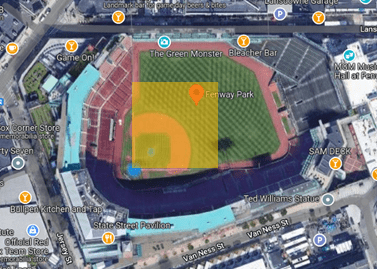
We have already determined the size of an acre is 43,560 square feet. That translates into a square that would be 208 feet by 208 feet.
Let’s give some context to the size visually.
Because I am a Massachusetts Real Estate Agent and we love our sports teams we will put some context to how big an acre is visually by using Gillette Stadium and Fenway Park.
The playing field of Fenway, home of the Boston Red Sox is roughly 2.35 acres with the entire stadium encompassing approximately 9 acres. The field itself is roughly 310 feet up the left foul line and 302 along the right foul line and center field 389 feet.
How Big Is An Acre Compared To Gillette Stadium Visually
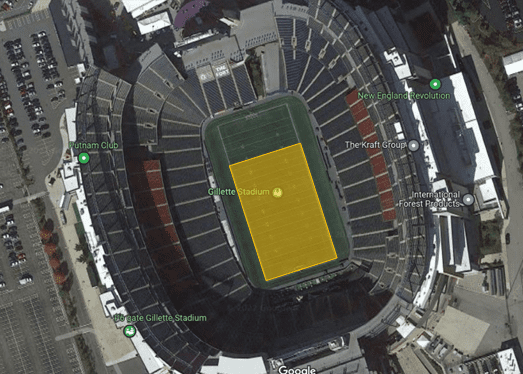
Now let’s see how big an acre is compared to Gillette Stadium. A professional football field is 160 feet by 360 feet including the end zone.
Gillette Stadium, the home of the New England Patriots has a ball field that is about 1.32 acres. An Acre encompasses approximately 70% of the field.
An acre would encompass the entire field from left to right including an end zone to the opposite 20-yard line.
Overall Gillette Stadium is 17.3 acres.
Not A Sports Fan
So maybe you are not a sports fan. Let’s take a look at another two references.
In the graphic below see how many subcompact SUVs would fit in the space.
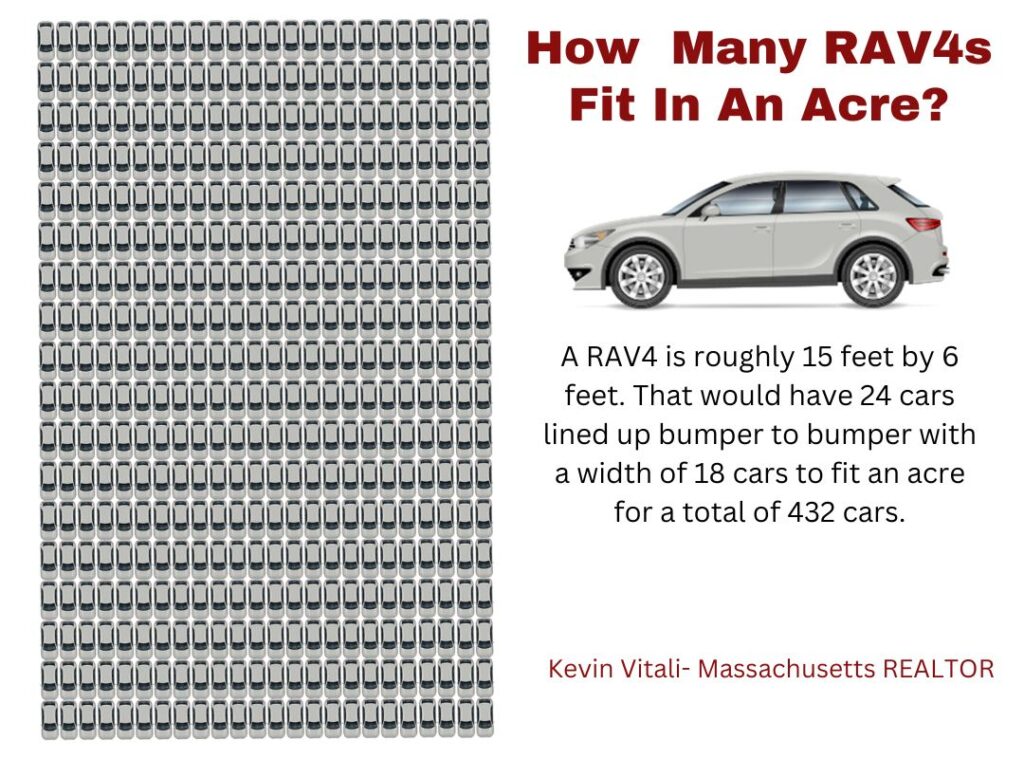
Or home many queen mattresses in a frame would fit in an acre? 1320 queen mattresses in a small frame would fit in 43,560 square feet or 1ac.
In this sample, we show a 28×40 2-story colonial (if this was a 2-story colonial the size would be a footprint of 1,120 square feet with a total of 2240 square feet). A 24×80 colonial would be a standard-sized colonial home of newer construction and you can see the relationship it would have to a one-acre lot.
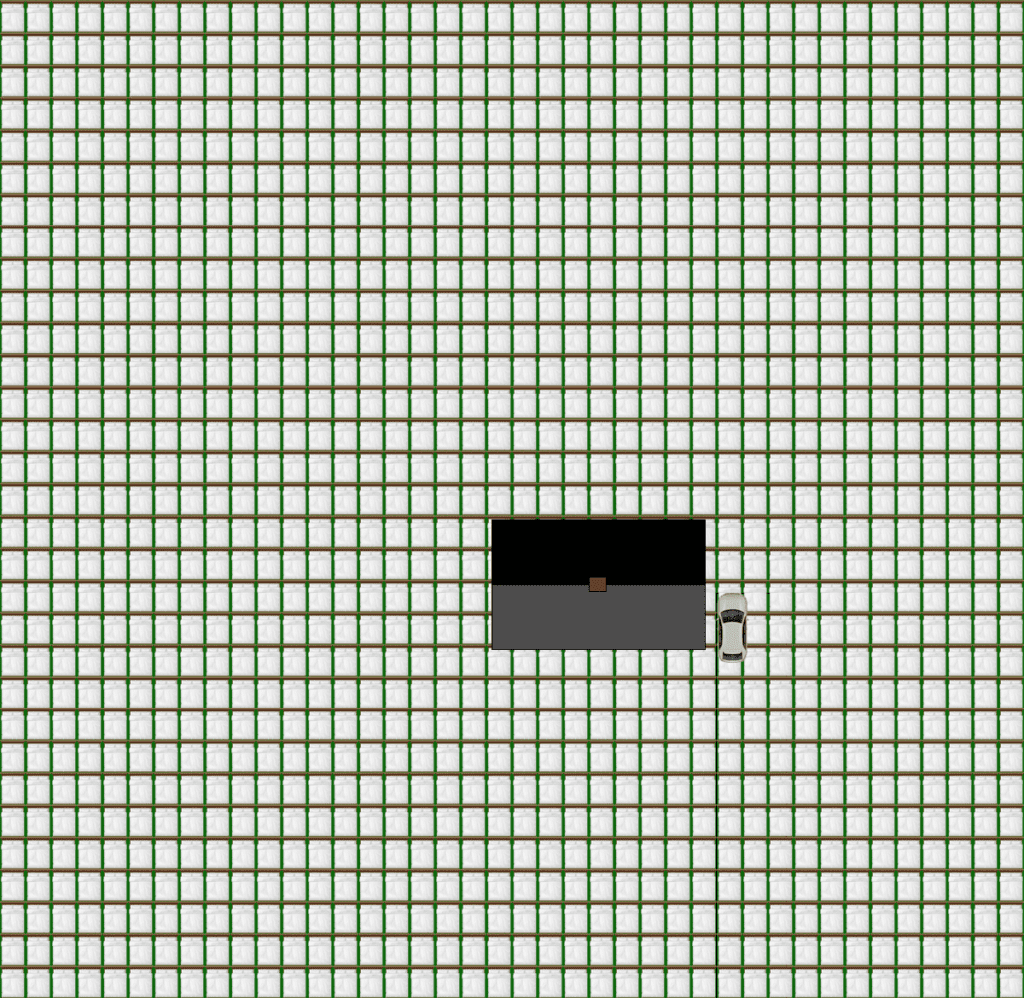
There Is More To A Lot Than Just Size
Many home buyers can hyper-focus on the acreage that a home sits on. In the Massachusetts MLS, a home’s lot size will show up in two ways: it will show the square footage and the acreage in a decimal point.
For example, a half-acre lot will be disclosed as 21,780 square feet or .50 acres.
Does More Acreage Mean My House Is Worth More Money?
The simple answer is maybe or maybe not.
In general, a building lot is a building lot. It doesn’t matter much if it is .5ac or 1.5ac you can still only get one house on the land. You can not say a home on one lot size that is double another it will be twice the value.
In areas with smaller lot sizes of 5000 to 7000 square feet, an additional 5,000 square feet or more could have an impact on your home’s overall value. But in areas where comparable homes sit on a half acre to an acre, 5000 square feet would have no impact or little impact on the land value.
Also, an agent will consider if the land is being used at its highest and best use. In my area, if large lots can be subdivided that certainly can significantly increase the value of your home.
One must also take into account other factors. The useability, privacy, easements running across the property, etc… can affect the value of the lot with a home. The additional value is highly location-specific and it is important to consult with a local REALTOR to see how your lot size impacts the price of your home.
How Much Does An Acre Of Land Cost?
The price of of an acre making up a plot of land can be influenced by a multitude of factors. Here are some of the major determinants:
-
Location: One of the most critical factors, the proximity of the acreage to urban centers, amenities, transportation hubs, scenic views, and other desirable areas can significantly influence land value.
-
Supply and Demand: In areas with limited land availability but high demand, prices tend to skyrocket. Conversely, in areas with abundant land and little demand, the price remain low.
-
Zoning and Land Use Restrictions: Local regulations can dictate how land can be used (residential, commercial, agricultural, etc.). Areas zoned for commercial or multifamily use, for instance, might have a higher value than those zoned only for agricultural use.
-
Size and Shape: Larger plots might fetch a higher total price, but the per-acre or per-square-foot price might decrease as size increases. The shape of the land (whether it’s easily buildable or not) can also influence its value.
-
Utility Access: Land that already has access to essential utilities like water, electricity, sewage, and internet might be more valuable than a plot where these need to be installed.
-
Topography and Soil Quality: Flat lands are generally more valuable for construction purposes. For agricultural land, soil fertility and quality are crucial. Wetlands, floodplains, or lands prone to natural hazards might be less valuable.
-
Market Conditions: Broader economic conditions, interest rates, and the state of the real estate market can influence land prices.
-
Potential for Development: If the land is perceived to have potential for future development or appreciation due to upcoming projects in the vicinity (like a new highway or commercial center), it may fetch a higher price.
-
Historical or Cultural Significance: Land with historical or cultural importance can have added value.
-
Environmental Factors: Clean land, free from contamination, is more valuable. Acreage with environmental issues or those near polluted areas tend to depreciate in value.
-
Access and Road Frontage: Easy access to major roads or highways can increase land value, especially for commercial purposes.
-
Property Taxes: Areas with higher property taxes might be less attractive to some buyers, potentially affecting land value.
-
Neighbors and Surrounding Developments: The type and quality of neighboring developments can influence land prices. An acre of land adjacent to a high-end development might be more valuable than one next to a poorly maintained property.
-
Ownership Title and Rights: Clear titles without disputes are crucial. Also, the rights that come with the acreage or land, such as mineral rights, water rights, or timber rights, can influence its value.
Understanding these factors provides a comprehensive picture of what drives the price of an acre of land, enabling buyers and sellers to make informed decisions in the real estate market.
Latest Essex County Homes For Sale
There Is More To A Lot Than Just Size
Many home buyers can hyper-focus on the acreage that a home sits on. In the Massachusetts MLS, a home’s lot size will show up in two ways: it will show the square footage and the acreage in a decimal point.
For example, a half-acre lot will be disclosed as 21,780 square feet or .50 acres.
Does More Acreage Mean My House Is Worth More Money?
The simple answer is maybe or maybe not.
In general, a building lot is a building lot. It doesn’t matter much if it is .5ac or 1.5ac you can still only get one house on the land. You can not say a home on one lot size that is double another is will be twice the value.
In areas with smaller lot sizes of 5000 to 7000 square feet, an additional 5,000 square feet or more could have an impact on your home’s overall value. But in areas where comparable homes sit on a half acre to an acre, 5000 square feet would have no impact.
Also, an agent will consider if the land is being used at its highest and best use. In my area, if large lots can be subdivided that certainly can significantly increase the value of your home.
One must also take into account other factors. The useability, privacy, easements running across the property, etc… can slightly affect the value of the lot with a home. The additional value is highly location-specific and it is important to consult with a local REALTOR to see how your lot size impacts the price of your home.
How Much Does An Acre Of Land Cost?
The price of of an acre making up a plot of land can be influenced by a multitude of factors. Here are some of the major determinants:
-
Location: One of the most critical factors, the proximity of the acreage to urban centers, amenities, transportation hubs, scenic views, and other desirable areas can significantly influence land value.
-
Supply and Demand: In areas with limited land availability but high demand, prices tend to skyrocket. Conversely, in areas with abundant land and little demand, the price remain low.
-
Zoning and Land Use Restrictions: Local regulations can dictate how land can be used (residential, commercial, agricultural, etc.). Areas zoned for commercial or multifamily use, for instance, might have a higher value than those zoned only for agricultural use.
-
Size and Shape: Larger plots might fetch a higher total price, but the per-acre or per-square-foot price might decrease as size increases. The shape of the land (whether it’s easily buildable or not) can also influence its value.
-
Utility Access: Land that already has access to essential utilities like water, electricity, sewage, and internet might be more valuable than a plot where these need to be installed.
-
Topography and Soil Quality: Flat lands are generally more valuable for construction purposes. For agricultural land, soil fertility and quality are crucial. Wetlands, floodplains, or lands prone to natural hazards might be less valuable.
-
Market Conditions: Broader economic conditions, interest rates, and the state of the real estate market can influence land prices.
-
Potential for Development: If the land is perceived to have potential for future development or appreciation due to upcoming projects in the vicinity (like a new highway or commercial center), it may fetch a higher price.
-
Historical or Cultural Significance: Land with historical or cultural importance can have added value.
-
Environmental Factors: Clean land, free from contamination, is more valuable. Acreage with environmental issues or those near polluted areas tend to depreciate in value.
-
Access and Road Frontage: Easy access to major roads or highways can increase land value, especially for commercial purposes.
-
Property Taxes: Areas with higher property taxes might be less attractive to some buyers, potentially affecting land value.
-
Neighbors and Surrounding Developments: The type and quality of neighboring developments can influence land prices. An acre of land adjacent to a high-end development might be more valuable than one next to a poorly maintained property.
-
Ownership Title and Rights: Clear titles without disputes are crucial. Also, the rights that come with the acreage or land, such as mineral rights, water rights, or timber rights, can influence its value.
Understanding these factors provides a comprehensive picture of what drives the price of an acre of land, enabling buyers and sellers to make informed decisions in the real estate market.
Use Google Maps to Measure An Acre Of Land
To measure an acre using Google Maps, follow these steps:
-
Open Google Maps: Go to Google Maps on your web browser.
-
Search for the Location: Enter the location of the land or area you want to measure in the search bar.
-
Switch to Satellite View: In the bottom-left corner of the map, click on the “Satellite” option for a clearer view of the land.
-
Right-Click on the Map: Once you’ve located the specific area, right-click on one corner of the land and select “Measure distance” from the dropdown menu.
-
Add Points to Measure: Click on the perimeter of the land, tracing the outline by adding points at each corner. Google Maps will calculate the distance between each point.
-
Close the Shape: To calculate the area, ensure you close the shape by connecting the last point to the starting point. The area in square feet (or meters) will appear in the measurement box at the bottom of the map.
-
Convert to Acres: Since Google Maps displays the area in square feet or square meters, divide the result by 43,560 to convert square feet to acres, or by 4,046.86 for square meters.
This method allows for a fairly accurate measurement, especially for irregularly shaped plots of land
Lorem ipsum dolor sit amet, consectetur adipiscing elit. Ut elit tellus, luctus nec ullamcorper mattis, pulvinar dapibus leo.
Acre FAQs
How many square feet are in an acre of land?
How long do I get support?
How does an acre compare to a football field?
How many acres are there in a square mile?
What are the dimensions of an acre if it's a perfect square?
Conclusion
In conclusion, understanding how big an acre is can help when buying or selling land, planning construction, or simply visualizing space. An acre is 43,560 square feet, which can take many shapes and sizes. Whether you’re comparing it to football fields, tennis courts, or parking lots, it’s important to recognize the different ways to visualize this measurement.
Especially in real estate, knowing the precise size of an acre can make a big difference when evaluating property and its value.
Other Real Estate Real Estate Resources
-
- Buying a house in cash has some distinct advantages. It certainly can get a seller’s attention. Paul Sian discusses the benefits of paying cash for a house. One point is you can pay cash for a house to take advantage of the benefits and then get a mortgage after the closing to maintain your cash reserves.
-
- With inflation soaring you may be wondering if it is a good time to buy a house. Vicki Moore discusses the impact inflation is having on the market and whether now is a good time to buy.

Author Bio
Kevin Vitali is a Massachusetts REALTOR out of Haverhill MA that serves Essex County and Northern Middlesex County in Massachusetts. If you want to buy or sell a home, let me use my years of experience to get you the best possible outcome.
Feel free to contact me to discuss any upcoming moves. I am always happy to answer your questions
Call 978-360-0422 Email kevin@kevinvitali.com


